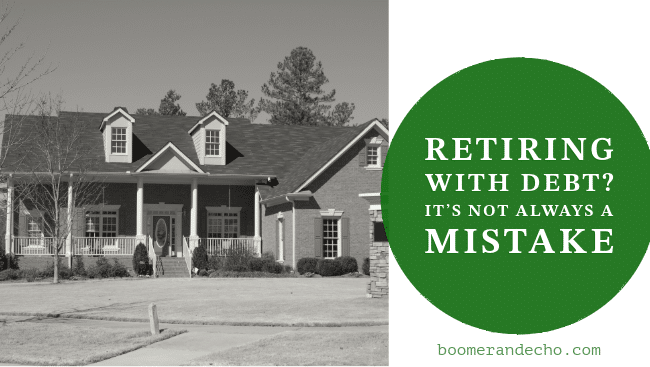
We’re often told to do everything we can to retire debt-free – that hanging onto a mortgage or car loan in retirement is a recipe for disaster. But like most blanket financial advice, context matters. And for many Canadians heading into retirement, especially those with defined benefit pensions and guaranteed government income, carrying a modest amount of strategic debt can actually make a lot of sense.
Let’s reframe the discussion and explore why being pension-rich but savings-poor might warrant a different approach to debt in retirement.
1. The Mortgage Balance: Don’t Drain Savings to Kill Debt
Imagine you’re 57 and set to retire in the next three years. You’ve got a DB pension that will cover your monthly expenses, but you still owe $120,000 on your mortgage. The temptation might be to throw every available dollar at that balance before you stop working.
But if that means neglecting your TFSA contributions, or leaving yourself with no accessible savings, you could be setting yourself up for a retirement liquidity trap.
Let’s say you have the ability to save an extra $18,000 per year in your final three working years. Throwing that entire amount at your mortgage will cut your amount owing in half by the time you retire, but you’ll still have a mortgage balance at retirement.
Worse, if you hit retirement with no savings outside your pension, you’ll struggle to handle larger one-time expenses – a new roof, a dental emergency, or helping out adult kids – and may be forced into suboptimal withdrawals or borrowing (dipping right back into your home equity with a higher interest rate line of credit).
Don’t forget that retiring at 60 also means you’re squarely in the retirement risk zone (the period between retirement and your government benefits kicking-in). Building up a margin of safety in savings is arguably much more important than being mortgage-free.
Better approach: Maintain your regular mortgage payments even if it means extending the pay-off date a few years into retirement. Direct your extra cash flow to your TFSA to build up liquid, tax-efficient savings.
2. Financing a Vehicle Beats Raiding Your Nest Egg
Another trap I see retirees fall into is the urge to pay cash for a new car, even if it means drawing down a large portion of their RRSP or modest TFSA balance.
Sure, debt-free sounds nice – but again, context matters. If you have steady, predictable monthly income from CPP, OAS, and a DB pension, you’re in a good position to handle a reasonable car payment.
And let’s not forget that pulling $40,000 from an RRSP could mean losing 30+% of that to taxes, especially if it pushes you into a higher marginal tax bracket. Suddenly that “debt-free” car looks a lot more expensive.
Then there’s Murphy’s Law, which states that as soon as you drain your savings for the vehicle purchase then your furnace dies or your dog needs an expensive surgery.
Better approach: Finance the vehicle at a reasonable interest rate, maintain your long-term investments, and keep your tax exposure low. Pension income gives you the monthly cash flow to support this without compromising your long-term security.
3. Set Up a HELOC *Before* You Need It
Once you retire, getting approved for new credit can be a challenge – even if you have excellent pension income. Banks love T4s and hate unpredictability, and post-retirement income often doesn’t fit their preferred lending model.
That’s why it’s smart to set up a Home Equity Line of Credit (HELOC) before you leave the workforce. You don’t have to use it – just think of it as another tool in your retirement toolbox.
A HELOC can be a safety valve for large, unexpected expenses: a surprise roof replacement, an uninsured medical procedure, or temporary support for a family member. Used wisely, it buys you time and flexibility, especially if your investments are temporarily down and you want to avoid selling at a loss.
Better approach: Apply for a HELOC while you’re still employed. In retirement, treat it like a standby tool — not a first line of defense, but a valuable option when needed.
Important Caveat
Before we wrap up, a quick but important caveat:
This is not me giving you permission to upgrade your house at 55 and carry a multi-six-figure mortgage until age 80. It’s not carte blanche for retirees with modest pension income to finance their retired life through debt.
I’m speaking very specifically to retirees or soon-to-be-retirees with one or maybe two strong, full-time, 30-year career pensions and little to no TFSA or non-registered savings. In these cases, modest, well-managed debt can act as a bridge – not a crutch – to maintain flexibility and peace of mind in retirement.
Final Thoughts: Debt Isn’t Always the Villain
This isn’t a blanket endorsement of carrying debt into retirement. But for those with stable pension income and limited savings, a rigid “debt-free or bust” mindset can be counterproductive.
Smart retirees think in terms of cash flow, liquidity, and flexibility – not just interest rates and balances.
As always, the key is intentional planning: understand your sources of income, your spending needs, and where debt – if any – fits into that picture without jeopardizing your future.
Sometimes, the best retirement strategy is less about eliminating all debt and more about retaining access to smart, low-cost financial tools that keep your options open.



Leave a Reply